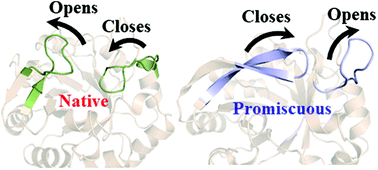The HisA enzyme catalyzes the first step of histidine biosynthesis via the Amadori rearrangement of the substrate ProFAR. Since it possesses the most conserved and ancient TIM-barrel fold, it provides an ideal framework for bioengineering of a new function from ancestral enzymes. In the present study, first, the catalytic mechanism of HisA biosynthesis was elucidated using hybrid Quantum Mechanical/Molecular Mechanical calculations, and thereafter, key residues contributing towards the promiscuity for TrpF activity were revealed using several MD simulations of a wild type enzyme and its variant with the native (ProFAR) and promiscuous (PRA) substrates. Our study reveals that the two loops (βα)1 and (βα)5 on the catalytic site of the HisA enzyme have incredible adaptability for the native and promiscuous substrates. The conformational interplay between these two loops is substrate driven and precise bioengineering targeting these loops is key to the emergence of new functions. Furthermore, the study reveals a key role of the Arg 15 residue which is close to the catalytic center of the enzyme in the bifunctionality of the HisA enzyme by increasing the loop flexibility. Therefore, our study provides crucial information for future bioengineering work to use the HisA enzyme as a scaffold for new enzymatic activity.
